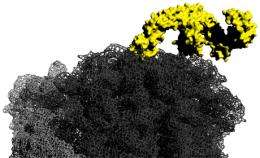New insights to the function of molecular chaperones

(Phys.org)—Heidelberg molecular biologists have gained new insights into the function of so-called molecular chaperones in protein synthesis. The team headed by Dr. Günter Kramer and Prof. Dr. Bernd Bukau of the DKFZ-ZMBH Alliance, a research association between Heidelberg University's Center for Molecular Biology (ZMBH) and the German Cancer Research Center (DKFZ), was able to demonstrate how a molecular chaperone in bacterial cells can influence the formation of the three-dimensional structure of new proteins.
"Our findings have put an end to a scientific controversy about the point in time within protein synthesis at which the folding of a protein into a defined three-dimensional structure begins and the roles played by individual factors involved in the process," says Prof. Bukau. The research findings have been published as an online article in Molecular Cell and are to appear in the journal's print version as well.
Proteins are produced by ribosomes, large molecular machines translating genetic information into long chains of amino acids. But these so-called polypeptide chains only turn into functional proteins after they have been folded into stable three-dimensional structures. Incorrectly folded proteins can have devastating effects on cells or even the whole organism. Examples are neurodegenerative disorders like Alzheimer's disease or Parkinson's disease. To prevent folding defects, cells have whole arsenals of folding assistants referred to as molecular chaperones. Some chaperones support folding during protein synthesis at the ribosome. Up to now, the precise details of this complex process were largely unknown.
The Heidelberg molecular biologists have now succeeded in supplying a more exact description of a chaperone called Trigger Factor from the bacterium Escherichia coli. To this end, all the components required for protein synthesis were isolated from bacterial cells and the protein folding process was observed during synthesis in the test tube. "It turned out that in the beginning of synthesis the growing polypeptide chain is prevented from folding by its spatial proximity to the ribosome," says Dr. Kramer. "This inhibition is reduced in the course of synthesis by the fact that the already synthesised parts of the growing chain are increasingly moved away from the ribosome by the addition of new amino acids." Trigger Factor prolongs the effect of the ribosome and also interferes with folding. In the course of translation it binds to the ribosome and the growing polypeptide chain, thus also preventing the folding of parts of the protein already further away from the ribosome. Accordingly, the ribosome and Trigger Factor act in concert to confine premature folding of the nascent polypeptide.
"The surprising thing is," says Dr. Kramer, "that Trigger Factor can also unfold parts of the protein." This activity of Trigger Factor can reverse premature folding attempts of the growing polypeptide chain and facilitate a new folding attempt if the earlier one was unsuccessful. "The essential point is that Trigger Factor only develops unfolding activity when it is attached to the ribosome. In other words, it cannot unfold fully synthesised proteins."
In conjunction with other findings produced by the Heidelberg research team, these new discoveries now represent an extended model of the molecular mechanism of protein folding. At the early stage of protein synthesis, the ribosome prevents premature folding of the growing polypeptide chain. Other important modifications to the protein chain have to be performed here as well. Trigger Factor is not involved at this stage. The binding of Trigger Factor keeps the growing polypeptide chain unfolded until sufficiently large parts of the protein are synthesised so that productive folding can take place. But if the protein has already undertaken premature folding steps when Trigger Factor binds, these steps can be reversed by the unfolding activity of Trigger Factor. In this way the formation of harmful proteins in the cell can be actively prevented. "These findings represent an important advance towards a more detailed understanding of the conversion of genetic information into functioning proteins," says Prof. Bukau. "This process is indispensable for the survival of every cell and every organism."
More information: Molecular Cell (2012), doi: 10.1016/j.molcel.2012.07.018
Journal information: Molecular Cell



















